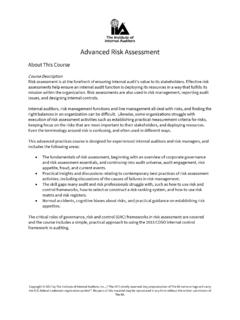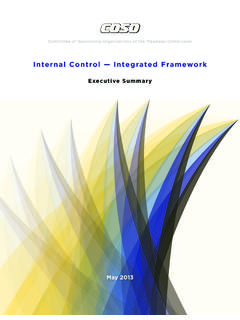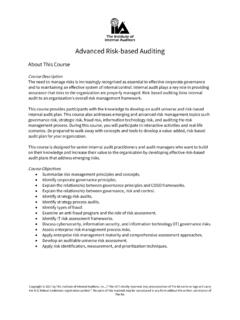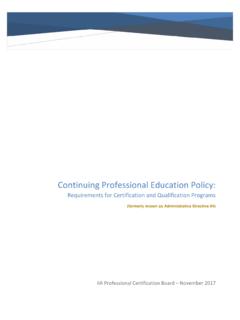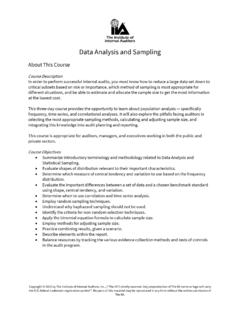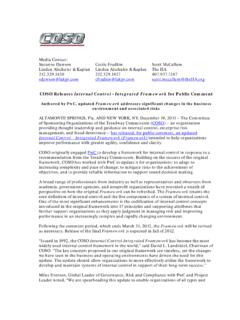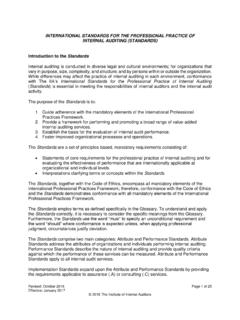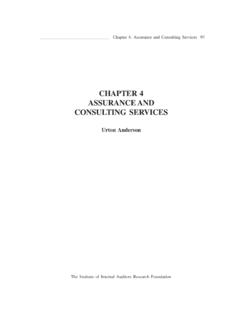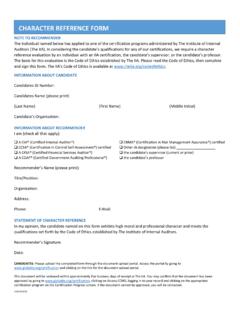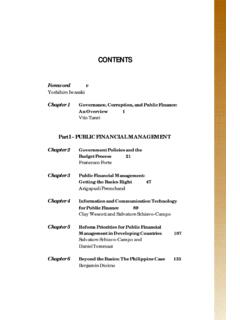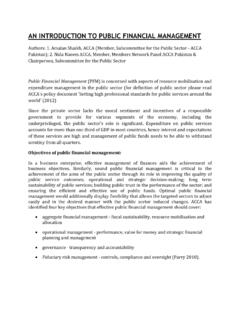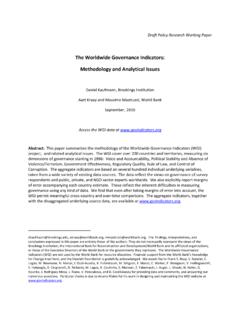Transcription of Public Sector Governance - The Institute of Internal Auditor
1 Supplemental Guidance: THE ROLE OF AUDITING IN Public Sector GOVERNANCE2nd EditionRelease Date: Jan. 2012 Supplemental Guidance: The Role of Auditing in Public Sector GovernanceTable of ContentsEXECUTIVE SUMMARY ..3 INTRODUCTION ..4 Public Sector Governance ..9 Public Sector AUDITING ..13 AUDIT AND OTHER OVERSIGHT COMMITTEES IN THE Public Sector ..23 CONCLUSION ..25 ABOUT THE AUTHORS AND REVIEWERS ..26 Executive SummaryThis second edition of The Role of Auditing in Public Sector Governance came about as a result of the extraordinary demand for guidance related to auditing in the Public Sector . Just as the first edition did, this edition presents information on the importance of the Public Sector audit activity to effective Governance and defines the key elements needed to maximize the value the audit activity provides to all levels of the Public Sector . The guidance is intended to point to the roles of audit (without differentiating between external and Internal ), methods by which those roles can be fulfilled, and the essential ingredients necessary to support an effective audit function.
2 As such, it may not be fully applicable in every jurisdiction, particularly where Public Sector audit roles and respon-sibilities are specifically defined by governing institutes or legal mandates to exclude certain functions or assign them to other entities. Supplemental Guidance: The Role of Auditing in Public Sector guidance presents the importance of the Public Sector audit activity to effective Governance and defines the key elements needed to maximize the value the Public Sector audit activity provides to all levels of the Public Sector . The principles discussed are relevant to national, regional ( , state or provincial), and local ( , county, city, or village) governments, as well as quasi-governmental and international government organizations. They also may apply to other publicly funded entities. In this guidance, all of these entities will be referred to as Public Sector organizations or guide is addressed primarily to elected and appointed Public Sector officials, as well as all advocates of good government.
3 Its purpose is to encourage readers to reflect on the Public Sector audit activities that now serve their jurisdictions and evaluate how those audit activities can be supported to fulfill their highest role in the Governance of Public Sector entities most effectively. In those jurisdictions where a Public Sector audit activity is needed, this guidance can provide the initial direction for decision-makers on the outcomes and services they should expect and the elements that are needed to establish an effective audit activity. Detailed guidance on the standards and other tools for creating and improving Public Sector audit services are available from The Institute of Internal Auditors (IIA).Supplemental Guidance: The Role of Auditing in Public Sector and External Auditing in a Public Sector ContextThis guidance addresses the role of Public Sector auditing, including both Internal and external Public Sector auditing. Myriad Public Sector audit activities and reporting rela-tionships exist among different jurisdictions and in different forms of government.
4 The key point, however, is that Public Sector audit activities must be configured appropriately to enable Public Sector entities to fulfill their duty to be accountable and transparent to the Public while achieving their objectives effectively, efficiently, economically, and ethically. Public Sector Governance Governance is defined as the combination of processes and structures implemented by the board to inform, direct, manage, and monitor the organization s activities toward the achievement of its objectives. In the Public Sector , Governance relates to the means by which goals are established and accomplished. It also includes activities that ensure a Public Sector entity s credibility, establish equitable provision of services, and assure ap-propriate behavior of government officials reducing the risk of Public corruption . The Role of Public Sector AuditingAuditing is a cornerstone of good Public Sector Governance . By providing unbiased, ob-jective assessments of whether Public resources are managed responsibly and effectively to achieve intended results, auditors help Public Sector organizations achieve account-ability and integrity, improve operations, and instill confidence among citizens and stakeholders.
5 The Public Sector Auditor s role supports the Governance responsibilities of oversight, insight, and foresight. Oversight addresses whether Public Sector entities are doing what they are supposed to do and serves to detect and deter Public corruption . Insight assists decision-makers by providing an independent assessment of Public Sector programs, policies, operations, and results. Foresight identifies trends and emerging challenges. Auditors use tools such as financial audits, performance audits, investiga-tions, and advisory services to fulfill each of these roles. Key Elements of an Effective Public Sector Audit ActivityAn effective Public Sector audit activity strengthens Governance by materially increas-ing citizens ability to hold their Public Sector entity accountable. Auditors perform an especially important function in those aspects of Governance that are crucial for promot-ing credibility, equity, and appropriate behavior of Public Sector officials, while reducing Supplemental Guidance: The Role of Auditing in Public Sector risk of Public corruption .
6 Therefore, it is crucial that audit activities are configured appropriately and have a broad mandate to achieve these objectives. The audit activity must be empowered to act with integrity and produce reliable services, although the specific means by which auditors achieve these goals vary. At a minimum, Public Sector audit activities need: Organizational independence. Organizational independence allows the au-dit activity to conduct work without interference by the entity under audit. The audit activity should have sufficient independence from those it is required to audit so that it can both conduct and be perceived to conduct its work without interference. Coupled with objectivity, organizational independence contributes to the accuracy of the auditors work and the ability to rely on reported re-sults. Independence is greatly impacted by how a chief audit executive1(CAE) is appointed and can be terminated. The International Professional Practices Framework (IPPF) Practice Advisory 1110-1 states that the CAE, reporting functionally to the board and administratively to the organization s chief execu-tive officer, facilitates organizational independence.
7 Important parts of this independence are the CAE s ability to be protected from management or politi-cal interference or retaliation resulting from carrying out legitimate duties in accordance with the Standards. The CAE also should be free to staff the audit activity without interference from management or undue political influence from Public formal mandate. The audit activity s powers and duties should be estab-lished by the Public Sector s constitution, charter, or other basic legal docu-ment. Among other topics, this document would address procedures and requirements of reporting and the obligation of the audited entity to collaborate with the Auditor . Unrestricted access. Audits should be conducted with complete and un-restricted access to employees, property, and records as appropriate for the performance of audit activities. 1 Chief audit executive (CAE) describes a person in a senior position responsible for effectively managing the Internal audit activity in accordance with the Internal audit charter and the Definition of Internal Auditing, the Code of Ethics, and The IIA s International Standards for the Professional Practice of Internal Auditing (Standards).
8 Different terminology may be used for the senior person responsible for managing an external audit activity. The term CAE will be used in this publication. However, the concepts gener-ally apply to both Internal and external audit Guidance: The Role of Auditing in Public Sector funding. The audit activity must have sufficient funding relative to the size of its audit responsibilities. This important element should not be left under the control of the organization being audited because the budget impacts the audit activity s capacity to perform its responsibilities. Competent leadership. The head of the audit activity must be able to independently and effectively recruit, retain, and manage highly skilled staff without undue managerial or political influence. The leader should be knowl-edgeable of applicable audit standards, professionally qualified preferably certified and competent to oversee and manage an audit function. Moreover, the CAE should be an articulate Public spokesperson for the audit activity.
9 Objective staff. An audit activity s staff must be objective. Audit staff must have impartial attitudes and avoid any conflict of interest. Conflict of interest is a situation in which an Internal Auditor , who is in a position of trust, has a com-peting professional or personal interest. A conflict of interest may exist even if no unethical or inappropriate act results. Such a conflict can create an appear-ance of impropriety that can undermine confidence in the Internal Auditor , the Internal audit activity, and the profession. Moreover, a conflict of interest could impair an individual s ability to perform audit duties and responsibilities staff. The audit activity needs a professional staff that collectively has the necessary qualifications and competence to conduct the full range of audits required by its mandate. Auditors must comply with minimum continu-ing education requirements established by their relevant professional organiza-tions and standards. Stakeholder support.
10 The legitimacy of the audit activity and its mission should be understood and supported by a broad range of elected and appointed Public Sector officials, as well as by the media and involved citizens. Professional audit standards. Professional audit standards, such as the International Professional Practices Framework (IPPF) promulgated by The Institute of Internal Auditors, support the implementation of the previous ele-ments and provide a framework to promote quality audit work that is system-atic, objective, and based on evidence. Just as many Public Sector entities have adopted Internal control standards either as requirements or guidance for Supplemental Guidance: The Role of Auditing in Public Sector Sector managers audit activities should conduct their work in accor-dance with recognized standards. The discussion on the following pages details key Public Sector Governance principles and describes the services and contributions that governments can derive from their audit activities.
